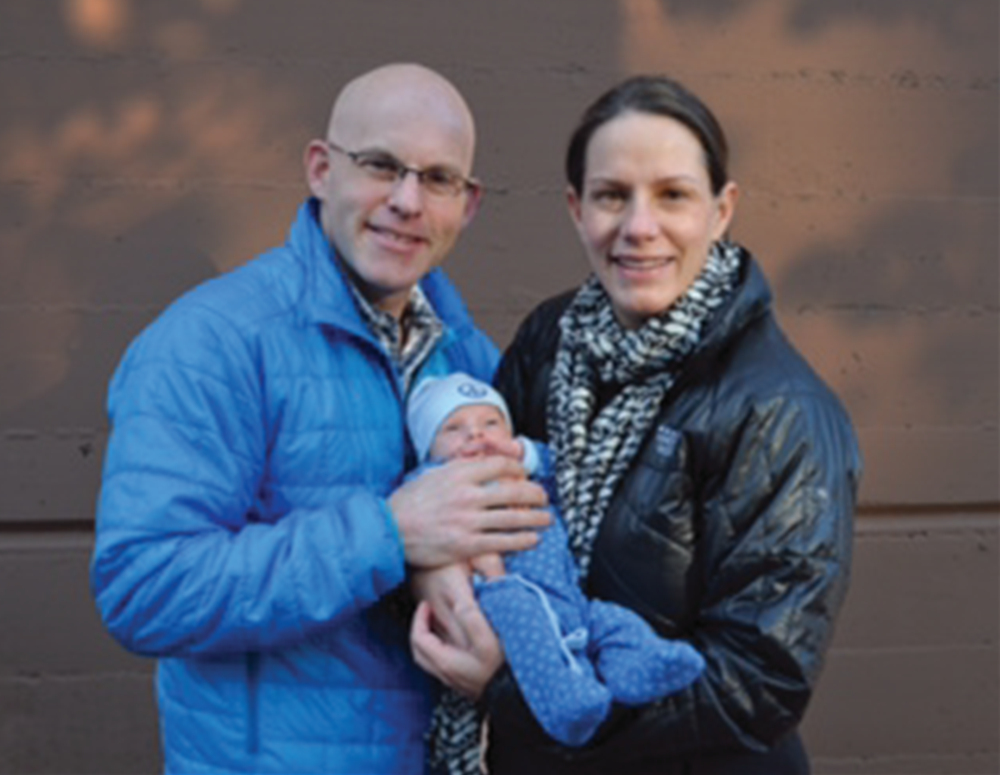
It was a typical Friday night in Serra. Loud rap music blasted from somewhere down the hall of the Stanford freshman dorm. Next to the trash can, empty pizza boxes were piled up next to empty beer bottles.
But inside suite 201, Adam Berkelhamer and Michelle Reininger M.A. ’04 Ph.D. ’07 unpacked bottles of a different kind: baby bottles.
The couple is serving in their second year as the dorm’s resident fellows (RFs) — live-in faculty members in charge of the dorm. Living with their first child, one-month-old Noll Eliot Berkelhamer, the couple admitted that at times, they have wondered if they might be in over their heads.
“Our friends think we’re crazy,” Reininger said, with a laugh.
But taking into account the pressure of the high cost of living for middle class faculty families — in contrast with the benefits of living expense-free on campus — and suddenly, Reininger and Berkelhamer don’t seem so crazy for choosing to raise their child in a freshman dorm.
In fact, Reininger and Berkelhamer are part of a growing trend.
The RF application process has become increasingly competitive in the last five years according to Deborah Golder, dean of Residential Education. These applicants have a few things in common — for one, their minivans.
Golder added that RFs appointed in 2013 alone raised the total number of RF children from 60 to 70. Reininger and Berkelhamer’s son born in December makes 71.
Golder views this trend in RF demographics — families with young kids — as beneficial to both RF parents and the University.
RFs are guaranteed free rent, free dining, full utility coverage, daycare and access to the Palo Alto public school system, not to mention the money saved by avoiding long commutes made by faculty living in surrounding areas like Mountain View, Menlo Park or Redwood City.
“The irony is, this is absolutely the cheapest we could be living right now, in the most expensive part of the world,” Berkelhamer said.
For Reininger and Berkelhamer, the decision to become RFs was more a last resort than a master plan.
After Reininger learned she was pregnant, the couple decided to move closer to campus, turning to faculty housing considering the high prices of the local market.
The San Francisco Chronicle projected a 2013 Palo Alto housing appreciation rate of 12 percent and not everyone can pay the price.
Faculty members aren’t guaranteed housing. And often, newly tenured faculty in the middle class bracket, like Reininger and Berkelhamer, are outbid.
Then the couple learned about the RF position.
“We were in panic mode, and we’re like, ‘We’re pregnant. Let’s do it,’” Reininger said.
Berkelhamer admitted that as a parent, he had reservations about the position at first.
The babies of RFs are exposed to more pathogens than most, and loud college students can easily wake up sleeping newborn infants (and their parents). Emmanuel Assa ’17, a student living in Serra, admitted he was skeptical about sharing his dorm with a toddler.
“He might overhear things from students that his parents don’t want him to hear,” Assa said.
Toyon Hall RF Marie-Louise Catsalis, the mother of two young boys, said she worries more about the overexposure in her son’s teenage years. Yet she recognizes some positive influence from such early exposure. For instance, her son Tobin, who is disgusted by underage drinking, serves as the dorm’s unofficial “alcohol monitor.”
“He knows that alcohol can hurt your brain, and make you act strange,” Catsalis said.
Catsalis also spoke of other benefits to raising her sons around Stanford students.
“Being around smart students, [the children] think earlier about the different things they can be when they grow up,” Catsalis said.
There are other more tangible future benefits for RFs’ children as well. With the University covering their cost of living, RFs are free to save for their futures. That means more money for college funds, insurance coverage and better housing.
Golder observed that with the money saved, some RFs have reportedly found themselves better positioned to become homeowners in the area.
However, RFs like Catsalis and her husband still count their 1,200-square-foot apartments — and untraditional lifestyles — among the sacrifices they must make in order to raise kids on faculty paychecks in Palo Alto.
Back in Reininger and Berkelhamer’s own 1,200 square-foot apartment, space is tight and compromises have been made.
But on the changing table in the nursery, Reininger and Berkelhamer unrolled a sprawling banner, filled with congratulations and signed by all 86 students in Serra, and insist this community has only made the trade-offs more worthwhile.
Contact Jaime Helyar at jhelyar ‘at’ stanford.edu.
